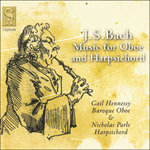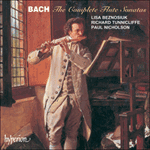The extent, if any, to which the Sonata in E flat major for flute and obbligato harpsichord, BWV1031, can be attributed to Bach remains in dispute. Probably dating from the early to mid-1730s this immediately appealing music may well be a joint venture of Bach himself and one or other of his two elder sons, perhaps Carl Philipp Emanuel. What is indisputable, however, is the high quality of its craftsmanship and its expressive charm. The opening ‘Allegro moderato’ is introduced by a delightful eight-bar melody played by the harpsichord, after which the flute enters with the main theme. The ‘Siciliano’ is rewardingly written for the flute, its musical substance recalling the first movement of Bach’s C minor violin sonata (BWV1017). In the spirited binary ‘Allegro’, with its repeated sections, there is effective interplay between the two upper parts, bringing this pleasing sonata to a lively conclusion.
from notes by Nicholas Anderson © 2002
On ne sait avec certitude dans quelle mesure Bach a pris part à la composition de la Sonate en mi bémol majeur pour flûte et clavecin obligé, BWV1031. Datant probablement du début ou du milieu des années 1730, cette musique d’une séduction immédiate pourrait bien avoir été écrite conjointement par Bach lui-même et l’un ou l’autre de ses deux fils aînés, peut-être Carl Philipp Emanuel. Ce qui ne fait cependant aucun doute, c’est la grande qualité de son écriture et son charme expressif. L’«Allegro moderato» initial est introduit par une délicieuse mélodie de huit mesures confiée au clavecin, puis la flûte entre à son tour et fait entendre le thème principal. L’écriture de la «Sicilienne» est gratifiante pour la flûte, sa substance musicale rappelant le premier mouvement de la sonate pour violon en ut mineur de Bach (BWV1017). L’«Allegro» fougueux, de forme binaire avec reprises, repose sur des échanges convaincants entre les deux parties aiguës, assurant à cette plaisante sonate une conclusion enlevée.
extrait des notes rédigées par Nicholas Anderson © 2002
Français: Josée Bégaud
Ob die Sonate in Es-Dur für Flöte und obligates Cembalo, BWV1031, Bach zugeordnet werden kann, und in welchem Maße, bleibt weiterhin umstritten. Diese unmittelbar reizvolle Musik, die wahrscheinlich aus der Zeit vom Beginn bis zur Mitte der 1730er Jahre stammt, mag gut eine Gemeinschaftsarbeit von Bach selbst und einem seiner beiden älteren Söhne (vielleicht Carl Philipp Emanuel) sein. Die hohe Qualität ihrer handwerklichen Kunst und ihr ausdrucksvoller Reiz sind jedoch unbestritten. Das eröffnende „Allegro moderato“ wird durch eine entzückende, vom Cembalo gespielte achttaktige Melodie eingeleitet, nach welcher die Flöte mit dem Hauptthema einsetzt. Das „Siciliano“ wurde auf lohnende Weise für die Flöte komponiert, und seine musikalische Substanz erinnert an den ersten Satz von Bachs Violinsonate in c-Moll (BWV1017). Im geistvollen, zweiteiligen „Allegro“ mit seinen wiederholten Abschnitten gibt es ein wirkungsvolles Wechselspiel zwischen den beiden Oberstimmen, das diese das Ohr erfreuende Sonate zu einem lebhaften Abschluss bringt.
aus dem Begleittext von Nicholas Anderson © 2002
Deutsch: Atlas Translations


 Bach: Music for oboe and harpsichord
Bach: Music for oboe and harpsichord Bach: The Complete Flute Sonatas
Bach: The Complete Flute Sonatas
